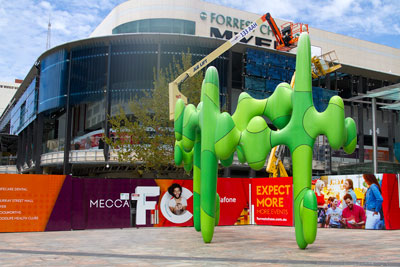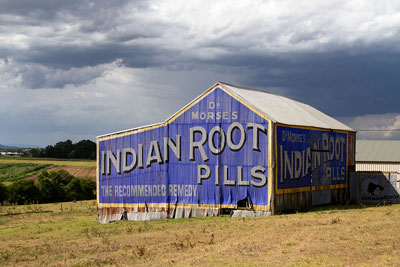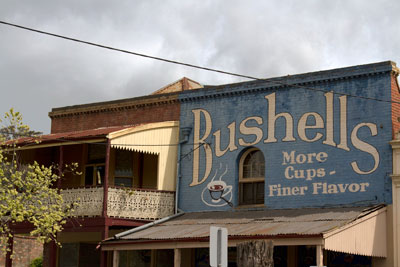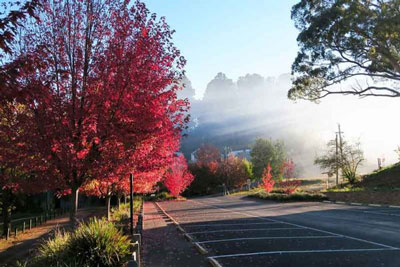25 facts about Melbourne for your next trivia night
Did you know that Melbourne used to be the capital of Australia? Or that it became the world’s second UNESCO Literature City? Or that St Kilda isn’t actually named after a saint? Here are some other facts about Melbourne, that you can use at your next pub quiz.

Think you know all there is to know about Melbourne?
Maybe. Maybe not.
There are certainly things about Melbourne that are surprising and delightful.
Personally, I love uncovering fun facts about Melbourne and sharing them with everyone I know (read: anyone who’ll listen).
Keen to learn more about the city before you visit, or due to a natural curiosity?
Read on to find out more.
Bizarre & interesting facts about Melbourne

1. Melbourne was nearly called Batmania
Melbourne is named after a Prime Minister of Britain (and by all reports, not a very notable one).
Did you know, that it was nearly named after a man called John Batman.
Batman is credited with signing a treaty with local the Kulin Aboriginal people in 1835, to acquire thousands of hectares of land, stretching from what is now the city of Geelong to Melbourne.
He started a village where Melbourne is today, declaring it to be ‘Batmania’, demonstrating the sort of humility present in so many men of his time.
Batman has long been heralded as someone who was kind or at least sympathetic to Australia’s Indigenous people.
However, a dive into history demonstrates may not quite be the case.
If you like, you can also blame him for beginning the destruction of the precious native grasslands extending from Melbourne out west.
These grasslands were decimated with subsequent grazing by settlers, after thousands of years of careful cultivation by Aboriginal Australians.
Less than 1% remains today.
With evidence surfacing that Aboriginal peoples were not nomadic and that Batman and friends were quick to renege on the terms of the treaty, you can see he probably doesn’t deserve the fuss that history has awarded him.
Although “Batmania” is a pretty cool name for a city, better to be remembered for a useless Prime Minister, than someone with a questionable history like Batman.

2. It’s a City of Literature
As a voracious bookworm, this is one of my favourite facts about Melbourne.
Although Melbourne is notable for its sporting background (which I’ll sadly have to address soon), many don’t know it’s an official UNESCO ‘City of Literature’.
We are in fact, the second city in the world to be granted this prestigious title, after Edinburgh in Scotland.
There are over 60 cities on the list, including Dublin, Baghdad, Québec City, Dunedin in New Zealand, Reykjavik and Seattle.
To be approved for this list, you need to meet a number of requirements, such as:
- possess a large diversity of quality publishing
- have literature or drama playing a big role
- boast libraries and bookstores which preserve, promote and disseminate domestic and foreign literature
- promote literature and strengthen the market for literary products.
With fantastic literary festivals in the city and regional Victoria, a proliferation of libraries and independent bookstores, strong local publishing scene and a city filled top the brim with bookworms, Melbourne is certainly deserves this title.
3. … & was named the world’s most liveable city 7 times in a row
Well, the secret is well and truly out.
Melbourne has been named the ‘World’s Most Liveable City’ an unbelievable seven times in a row.
To make the top ten, you have to achieve near perfect scores in healthcare, education and infrastructure.
Vienna stripped us of our crown in 2018, which was perhaps a bit of relief. It’s a lot of pressure to be the most liveable city in the world. There can be too much of a good thing!
Regardless, Australian cities regularly make the top ten.
Rapidly rising living expenses and stagnant wages must not be a factor in making this list!

4. …& it’s the sports capital of the world
Sigh. I knew I’d have to mention the sports eventually, as one of the undeniable facts about Melbourne.
Melbourne has taken out the worldwide crown in 2006, 2008, 2010 and 2016.
There are notable sporting events held throughout the year in Melbourne, such as the Formula 1 Grand Prix, The Melbourne Cup and the Australian Open.
Melburnians themselves (and most of Australia, truth be told) are mad about sport, particularly cricket and the homegrown game of Aussie Rules.
It doesn’t get much attention outside of Australia, but “the game” here is treated like religion. It packs full our giant sports stadium the MCG, on a regular basis.
Say what you will about the sports (and I will). They’re held sacrosanct by many members of the public here.
5. Inhabitants of the city (and state of Victoria) get two days a year off work due to the sports
In fact, Victorians are given not one, but two public holidays during the working year, thanks to sporting events.
The new-ish “Grand Final Public Holiday” is held the Friday before the AFL Grand Final, in late September.
A few weeks later, the state collectively takes a Tuesday off in early November due to the ‘race that stops a nation’ – the Melbourne Cup.
That’s how crazy about sport the city is.

6. Aussie Rules football kicked off in Melbourne
Now the most popular sporting code in the country, Aussie Rules started around 1858, influenced by similar games of football popular in Britain and Ireland.
On 31 July 1858, the Melbourne Football Club (now known colloquially as the “Demons”) came into existence. Leagues sprung up in South Australia and Victoria soon after.
The Victorian Football League became the Australian Football League (the AFL) in the 1990s.
With 18 teams in the league, Australian rules football is now the main winter sport played in Victoria, South Australia, Western Australia and Tasmania.
7. The world’s first feature film was made in the city
That’s more than enough about the sports. Let’s inject some culture back into this post. Please.
Film enthusiasts will be delighted to learn that the world’s first feature film was made in Melbourne.
The 1906 Australian bushranger film The Story of the Kelly Gang is a multi-reel film around 1,200 metres (4,000 ft), shot around Melbourne.
Ned Kelly had only been executed 26 years earlier and members of his immediate family were still alive at the time the silent film premiered.
Simiarly, the Melbourne International Film Festival is one of the world’s oldest film festivals, running since 1952.

8. The city’s Luna Park has the oldest continuously operating roller coaster in the world
Here’s some facts about Luna Park in Melbourne, one of the city’s oldest tourist attractions.
An icon of Melbourne, the park opened in 1912 and has been running almost continuously ever since (let’s ignore disruptive pandemic-related lockdowns on this point).
The Scenic Railway scaling the park’s perimeter, was one of the first rides to be installed and remains there to this day.
While the park was closed for the First World War, the scenic railway continued to run during these years.
It’s one of a kind, with a standing brakeman in control aboard its moving carriages.
The park’s Ghost Train is also one of few last dark rides in the world.
Luna Park certainly is one of the most interesting places in Melbourne.
9. Melbourne was Australia’s capital city for 26 years
The gold rush era of the 1850s brought massive growth and prosperity to the new city. This caused it to exceed Sydney in population growth.
So, when Australia broke away from British rule to form its own Commonwealth between the six colonies in 1901, the new seat of government sat at Parliament House in Spring Street.
Victorian Parliament relocated to the Royal Exhibition Building, nearby.
Despite Sydney’s growth in population from 1905, Melbourne remained the temporary capital for 26 years.
The two major cities squabbled continuously over who should wear the crown of capital.
In the end, an entire city was created to stop the two bickering.
Canberra was designed by Chicagoan Walter Burley Griffin in collaboration with Marion Mahony Griffin. Parliament House was officially opened in May, 1927.
One of the more interesting facts about Melbourne – although Sydney is currently the most populous city in Australia, Melbourne is set to outgrow its competitor sometime in the next decade.

10. The popular suburb of St Kilda is not named after a saint
Head to St Kilda and you might wonder who on earth the suburb’s eponymous saint actually is.
St Kilda, Saint Kilda… it’s not actually ringing any bells, is it?
Well, that’s because there is or rather was, no St Kilda. At least, not of a holy variety.
In actual fact, the suburb is named after a boat. The Lady of St Kilda, was a large trading ship that pulled up in Melbourne in 1842.
It remained there for such a time, that locals began referring to the area as the ‘St Kilda foreshore’ – as it is now known today.

11. The city is home to the largest stained glass ceiling in the world
The National Gallery of Victoria is renowned for many reasons.
It’s a stellar art gallery, probably the grandest in Australia and receives world-class exhibitions.
Founded in 1861, it’s certainly the oldest, largest and most visited art museum in the country.
Along with this, NGV International is home to the world’s largest stained-glass ceiling, designed by Australian artist Leonard French.
It’s located in the Grand Hall, which opened in 1968.
The ceiling itself is over 13 metres high and 60 metres long, propped up by steel columns.
An honoured past time by young Melburnians and visitors alike, is to lie down on the carpeted floor and stare up at the ceiling, taking in all the colours at once.
12. Melbourne is the live music capital of the world
Turns out Melbourne is the place to be if you’re a music fan, with its gigs attracting more people than its sporting events.
And as previously noted, this is saying a lot.
Apparently, 17.5 million people attended gigs in 2018.
Plus, the city has a venue for every 9503 residents.
So, if music is your thang, Melbourne certainly is your city.

13. The David Jones in the city was once a giant book arcade
This one of the facts about Melbourne that I find most upsetting.
Edward William Cole opened what was to become the largest bookstore in the world at that point in time, on the 27 January 1883, right in the heart of Melbourne.
Cole’s Book Arcade, also known as the Palace of Intellect, was on the site of what is now the Men’s store of the David Jones in Bourke Street Mall.
By 1906, this book arcade was two blocks in size, extending all the way through to Collins Street and included a beautiful glass roof, which Cole built at his own cost.
Not only books were housed here – there was a menagerie, performances, confectionary, a toyland and a stationary department, among other bizarre things.
People were encouraged to stop and read in the comfortable chairs spread around the arcade. This was encouraged by a sign that stated: Read As Long As You Like – Nobody Asked to Buy. Yes please.
Of course, what sounds like heaven on earth couldn’t last.
Although the business continued after Cole’s death in 1918, the land was eventually sold and the arcade demolished.
You can see what’s left of the Cole’s Book Arcade in the roof of tiny Howey Place, one of Melbourne’s beautiful laneways.
Read more about this incredible place here.
14. Melbourne was home to the ‘six o’clock swill’ until 1966
Although a boozed-up Aussie is a familiar stereotype around the world now, Australian drinking customs were far more reserved in the middle of last century.
Liquor licensing laws that were introduced in 1916, forced public bars to close at 6pm. This left a mere hour for folks to swig a few drinks at the end of a working day.
This didn’t mean that drinking was in any way moderated. Oh, no.
Workers would rush to the bar, to share a beer before they headed home to their long-suffering families for tea time.
This resulted in a loud, gross, crush of bodies, with beer being spilled everywhere.
It was described as a melee, or a pig swill and soon began to be known as the ‘six o’clock swill’.
Visitors were blown away by the all-male rush to the bar for beer before closing.
Some feared this added to the overall ‘provincial’ feel of the city.
It took another ten years, but the laws were eventually revised, with Victoria being the last state to lift the ‘after six drinks’ ban in 1966.

15. An Australian Prime Minister disappeared not far from Melbourne
This isn’t just a Melbourne fact really… it affects all of Australia.
Australia goes through Prime Ministers like it’s changing underwear, but it’s been awhile since we’ve had one disappear off the face of the planet.
This did happen, back in December 1967.
Harold Holt, then Liberal PM was hanging around Cheviot Beach down the Mornington Peninsula, when he decided he fancied a dip.
This was nothing out of the ordinary. Holt had a holiday house nearby and knew the area well.
His companions didn’t think it was such a flash idea – the surf was rough and the Prime Minister had been in ill health of late.
Holt decided he knew best, as is the way with these sort of political personalities and strode into the ocean, swimming out past the breakers.
He dipped beneath the waves and disappeared from sight.
Extensive searches failed to bring up anything.
His body was never found.
This led to a bunch of theories springing forth, most holding the opinion that Holt didn’t actually drown.
He was accused of being a Russian spy, or working for the CIA, as was the conspiracy-related flavour at that point in history.
Everyone loves a mystery.
Want to pay tribute to our lost PM? Well, head on over to the ‘Harold Holt Memorial Swimming Centre’ in Glen Iris.
No one can say we Aussies don’t have a sense of humour, twisted as it may be.
16. There’s a grave dedicated to Elvis in Melbourne Cemetery
This is one of the more truly interesting facts about Melbourne, as ‘The King’ never toured Australia.
However, this didn’t stop the Elvis Presley Fan Club of Australia putting together a memorial in November 1977.
The Elvis Presley Memorial Garden can be found in Melbourne General Cemetery and is believed to be the only one of its kind in Australia.
It reputedly draws thousands of visitors on the anniversary of Elvis’ death (he died 16 August, 1977).
I’m sure if he were able to do so, the King would say: “Thank you – Thank you very much” (I know I’m not funny).
Unsurprisingly, the cemetery is one of the spookiest places in the city. Discover other haunted places in Melbourne.

17. Melburnians are somewhat obsessed with bathing
Melburnians were reputedly (and hopefully still are) a clean bunch, and have a history of public bathing.
People used to dip in the Yarra (a thought that repulses me when I look at it today) bathe in the sea, as well as the numerous city baths.
This history is evident in the private bathing boxes scattered around our southern beaches.
The best known are the colourful boxes lining Brighton Beach, south east of the city.
They’re only allowed to be sold to residents of the affluent area and are usually passed down from family to family.
One of the more incredible facts about Melbourne – when they (rarely) go on the market, they can fetch upward of $300,000 – a price that reflects the status symbol that they’ve now become.

18. An ex-premier’s face is carved onto the side of a church
Head to St Patrick’s Church just outside the CBD, turn right at the front doors and walk around the side. You will be greeted by a most amusing sight.
It’s the face of ex-Premier Jeff Kennett, transformed into a gargoyle and adorned onto the side of the church.
Stonemason Tom Carson carved two new gargoyles for St Patrick’s in 1992.
He decided on a whim, that he’d use Kennett’s long, distinctive face as a model for one of them.
I’m not entirely sure that Kennett deserves to be immortalised in this way, but it is still a fairly amusing sight.
19. The fight for the 8 hour working day in Australia was won in Melbourne
Now onto more historic facts about Melbourne.
Stonemasons on the 21 April 1856 downed their tools and walked off the job, in protest of employer’s refusal to accept their demand for reduced working hours.
They’d previously been working 6, or 7 days a week, for around twelve hours.
Labour movement leaders believed it was only fair to work 8 hours – giving workers another eight to sleep and another eight to ‘play’.
Shortly after the peaceful and popular demonstration, legislation was introduced into Parliament and passed shortly afterwards.
A monument to these workers was erected in the city in 1902.
It also lead to the introduction of the first paid public holiday – aptly titled “Labour Day”, it’s celebrated on different days around the country.

20. A lake in the city commonly turns pink over the summer
There’s a few salt lakes in Australia, but most are miles away from major cities.
Not the Westgate Park salt lake, which is located west of the city centre.
After a summer of not very much rain and hot temperatures, the lake will turn a rather fetching shade of pink, drawing visitors from just about everywhere.
It’s the salt that does it. Algae growing in the lake produces a red pigment under certain conditions, as part of the process of photosynthesis.
This algae has known to be particularly effective in luring Instagrammers, who come far and wide, to only profess a certain disappointment that the lake looks ‘more pink’ on the app.
Ah. The power of a strong saturation filter.
21. The second mace of Parliament disappeared off the face of the earth
Victorian parliament isn’t exactly old, yet they’re already onto their third Parliamentary Mace.
First of all, what on earth is a mace?
Well, it’s a symbol of both the office of the speaker and the constitutional rights of the state’s citizens – so no big deal, or anything.
The first, made out of timber, was replaced by a fancy, new model.
It was five feet long, silver-plated and quite ornate looking.
And, it hasn’t been seen since the 9th of October, 1891.
The disappearance of this mace has remained one of Melbourne’s favourite unsolved crimes, perhaps not on the same scale at London’s Jack the Ripper, but surely up there?
Various parliamentary workers have been accused of stealing the mace.
However, the most popular theory is that a bunch of parliamentarians went a bit too heavy on the booze and ended up tossing the thing in the river.
There were also rumours that the mace was taken to a brothel on Little Lonsdale Street, and used in some less than proper proceedings.
It was presumably left there, which is perhaps for the best, as who would want to be near it after that?
Whatever the case, no one’s seen hide nor hair of the thing since, despite a $50,000 reward currently being on offer.
The first mace currently resides above the door of the parliamentary library.
And the third mace? Well, it’s kept safely locked away in the Speaker’s study.
Wouldn’t want history to repeat itself, after all.

22. There’s an entire solar system in Melbourne
A fact about Melbourne that’s truly out of this world.
In the seaside suburbs of St Kilda and Port Melbourne you’ll find a truly unique art trail.
The St Kilda Solar System Trail curls along the City of Port Phillips foreshore, starting with the sun and ending with Pluto.
Built to scale, every centimetre you walk is 10,000kms. Pluto is a staggering 5.9 billion kilometres from the sun, but along this trail it is 5.9kms.
Likewise, the sun measures 139cms across, to represent its 1,392,000 km diameter. The earth is a tiny 1.28 cm.
Find out more about the trail and perhaps walk it yourself!
23. You can find penguins just outside the city
Melbourne is home to a population of fairy (or little) penguins.
The best place to see them is on Phillip Island, where they’ll scuttle from the sea up the shore to sleep for the night.
There’s a colony that also call St Kilda home. If you time it right, you can see them just after sunset.
Make sure you keep your distance and don’t photograph them with a flash, as it’s not good for their sweet little eyes.
24. Melbourne hosted the first Olympics outside of Europe or North America
More facts about Melbourne for the sports fans!
The Sydney 2000 Olympics in some way brought both the city and Australia to the national stage.
Did you know that Melbourne hosted the 1956 Games, the first to be held in Australia?
Consequently, the team we sent to this Olympics is one of our best ever, featuring star swimmers such as Dawn Fraser and Murray Rose and sprinters Betty Cuthbert and Shirley Strickland. We placed third overall, the highest ever by an Australian team.
It’s not all good news. Unfortunately, in a bid to ‘modernise’ the city, many of Melbourne’s historic buildings were demolished, many of which heralded back to the city’s inception and flash goldrush era.
The next Australian Olympics will be held in Brisbane in 2032.
25. Melbourne endured the longest lockdowns in the world during 2020 & 2021
Of all the facts about Melbourne in this post, this is my least favourite.
While not having nearly as many cases as the rest of the world until 2022, Australia went hard on its lockdowns from day one of COVID-19.
An initial six-month lockdown allowed most of the country to enjoy some normality for most of 2020.
However, breaches in hotel quarantine saw Melbourne and then Victoria enter a second lockdown in early July, which dragged on for months.
At the time, Melbourne had some of the harshest restrictions in the world.
Remarkably, we were able to squash our COVID cases from over 700 in July to zero.
The day is affectionately referred to as Doughtnut Day. No other city in the world has achieved this.
Unfortunately, Australia’s abysmal vaccine rollout lead to more lockdowns, include another epic few months in both NSW and Victoria.
Melburnians were released from lockdown after achieving a vaccination rate of 90% and in the process, became the most locked down city in the world.
So, there you have it – some interesting facts about Melbourne. Are you feeling most knowledgeable after reading this post? Anything else you’d like to add to this list? Let me know in the comments!
You might also like:
- 30 things to do during winter in Melbourne
- 40 weird facts about Australia
- Strange facts about Perth & Western Australia
- 150+ slang words to have you speaking like a Dinky-di Aussie









